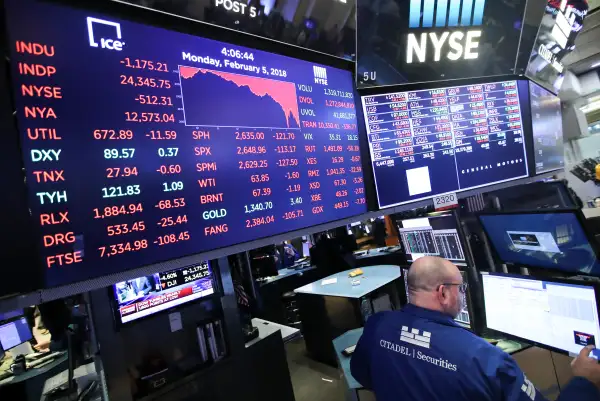The Market Crash's Biggest Loser Is Down 94% in One Week
Money is not a client of any investment adviser featured on this page. The information provided on this page is for educational purposes only and is not intended as investment advice. Money does not offer advisory services.

The stock market has begun to recover from its epic slide — in which the Dow Jones industrial average lost as much as 10.7% of its value at one point.
But not all investments are bouncing back so easily.
Earlier this week, exchange-traded portfolios that allow investors to bet against stock market volatility — in other words, to bet that Wall Street will be calm and orderly — lost most of their value in a matter of days, making them the biggest losers by far in this meltdown.
VelocityShares Daily Inverse VIX Short-Term ETN (ticker symbol: XIV) plunged more than 94% in just the past week, while ProShares Short VIX Short-Term Futures ETF (SVXY) sank more than 89%.
Why Rising Volatility Hurts These Funds
Trading had actually been halted briefly in these funds, which promise to deliver the inverse performance of the CBOE Volatility Index, or VIX. The so-called VIX index is often referred to as the "fear gauge," as it measures expected short-term volatility in the market.
In recent years, investors made out like bandits in these funds, since market volatility had fallen to historic lows as the bull market kept chugging along and market fears dissipated. Last year, these funds nearly tripled in value.
But as the VIX index soared this week, more than doubling from Monday’s closing price to Tuesday’s open, inverse VIX funds crashed.
Even though the stock market sell-off has reversed, the VIX remains at higher-than-average levels on Wednesday.
Credit Suisse announced on Tuesday that it would liquidate the VelocityShares Daily Inverse VIX Short Term ETN on Feb. 21, after the dramatic fall in value.
ProShares officials said they would continue to manage ProShares Short VIX Short-Term Futures as usual.
Why You Should Beware Even if Volatility Dies Down
The jump in the VIX is a sign that volatility has returned to the market, now that fears of inflation have increased.
But even if you think market volatility will subside, the sudden sell-off exposed major risks to using these investments.
These funds try to track the inverse of the CBOE Volatility index, and use derivatives to replicate the inverse action of the VIX on a daily basis.
"Daily" is the key word here. These funds reset every day. And what that means is, in the long run, you won't get predictable results from these investments.
Michael Iachini, head of ETF research at Charles Schwab Investment Advisory recently outlined the problem using simple math.
Say you were to invest $10,000 in an inverse volatility fund and the VIX drops from a reading of 10 to 9. That would represent a 10% fall in the index, meaning your inverse investment would now be worth 10% more, or $11,000. That’s the good side of the coin.
But these indexes reset on a daily basis. So let's assume the next day the VIX rises back up to 10. Going from a reading of 9 to 10 represents an 11.1% gain in the VIX, forcing inverse VIX funds to fall by 11.1%.
That means you would have $9,779.00 at the end of two days, even though the VIX sits at the exact same spot when you originally invested your $10,000.
Over the long-term, this daily rebalancing will only compound as the price fluctuates, which worsens if the product promises two times or three times the return of the index it’s tracking.
The funds themselves admit that they aren’t meant for long-term investing. “They are designed to achieve their stated investment objectives on a daily basis, but their performance over longer periods of time can differ significantly from their stated daily objectives,” reads XIV’s prospectus.
Before this week’s pullback, that didn’t stop money from flowing in during the eight-year bull-run, ballooning the XIV to $1.6 billion in assets since its launch in 2010.
It may be time to start reading the prospectus.
